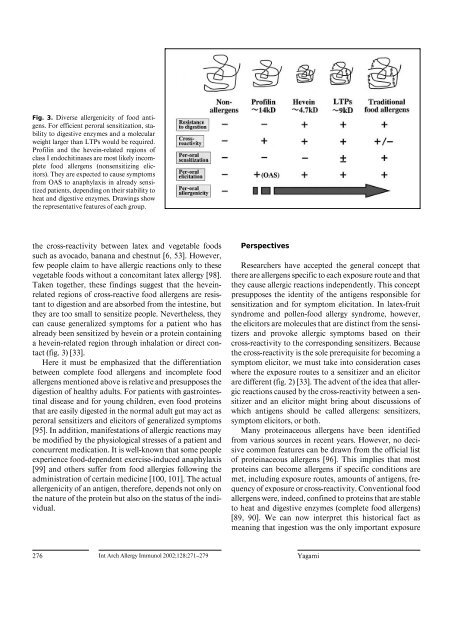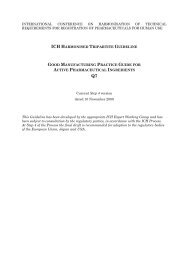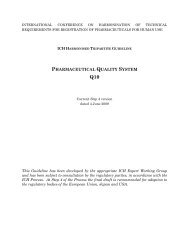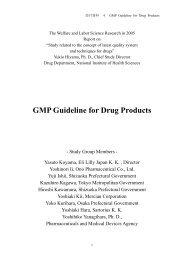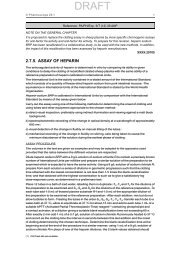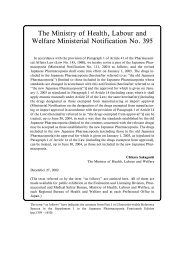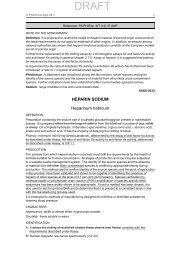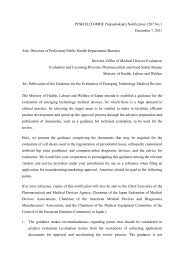Allergies to cross-reactive plant proteins. Latex-fruit ... - NIHS
Allergies to cross-reactive plant proteins. Latex-fruit ... - NIHS
Allergies to cross-reactive plant proteins. Latex-fruit ... - NIHS
Create successful ePaper yourself
Turn your PDF publications into a flip-book with our unique Google optimized e-Paper software.
Fig. 3. Diverse allergenicity of food antigens.<br />
For efficient peroral sensitization, stability<br />
<strong>to</strong> digestive enzymes and a molecular<br />
weight larger than LTPs would be required.<br />
Profilin and the hevein-related regions of<br />
class I endochitinases are most likely incomplete<br />
food allergens (nonsensitizing elici<strong>to</strong>rs).<br />
They are expected <strong>to</strong> cause symp<strong>to</strong>ms<br />
from OAS <strong>to</strong> anaphylaxis in already sensitized<br />
patients, depending on their stability <strong>to</strong><br />
heat and digestive enzymes. Drawings show<br />
the representative features of each group.<br />
the <strong>cross</strong>-reactivity between latex and vegetable foods<br />
such as avocado, banana and chestnut [6, 53]. However,<br />
few people claim <strong>to</strong> have allergic reactions only <strong>to</strong> these<br />
vegetable foods without a concomitant latex allergy [98].<br />
Taken <strong>to</strong>gether, these findings suggest that the heveinrelated<br />
regions of <strong>cross</strong>-<strong>reactive</strong> food allergens are resistant<br />
<strong>to</strong> digestion and are absorbed from the intestine, but<br />
they are <strong>to</strong>o small <strong>to</strong> sensitize people. Nevertheless, they<br />
can cause generalized symp<strong>to</strong>ms for a patient who has<br />
already been sensitized by hevein or a protein containing<br />
a hevein-related region through inhalation or direct contact<br />
(fig. 3) [33].<br />
Here it must be emphasized that the differentiation<br />
between complete food allergens and incomplete food<br />
allergens mentioned above is relative and presupposes the<br />
digestion of healthy adults. For patients with gastrointestinal<br />
disease and for young children, even food <strong>proteins</strong><br />
that are easily digested in the normal adult gut may act as<br />
peroral sensitizers and elici<strong>to</strong>rs of generalized symp<strong>to</strong>ms<br />
[95]. In addition, manifestations of allergic reactions may<br />
be modified by the physiological stresses of a patient and<br />
concurrent medication. It is well-known that some people<br />
experience food-dependent exercise-induced anaphylaxis<br />
[99] and others suffer from food allergies following the<br />
administration of certain medicine [100, 101]. The actual<br />
allergenicity of an antigen, therefore, depends not only on<br />
the nature of the protein but also on the status of the individual.<br />
Perspectives<br />
Researchers have accepted the general concept that<br />
there are allergens specific <strong>to</strong> each exposure route and that<br />
they cause allergic reactions independently. This concept<br />
presupposes the identity of the antigens responsible for<br />
sensitization and for symp<strong>to</strong>m elicitation. In latex-<strong>fruit</strong><br />
syndrome and pollen-food allergy syndrome, however,<br />
the elici<strong>to</strong>rs are molecules that are distinct from the sensitizers<br />
and provoke allergic symp<strong>to</strong>ms based on their<br />
<strong>cross</strong>-reactivity <strong>to</strong> the corresponding sensitizers. Because<br />
the <strong>cross</strong>-reactivity is the sole prerequisite for becoming a<br />
symp<strong>to</strong>m elici<strong>to</strong>r, we must take in<strong>to</strong> consideration cases<br />
where the exposure routes <strong>to</strong> a sensitizer and an elici<strong>to</strong>r<br />
are different (fig. 2) [33]. The advent of the idea that allergic<br />
reactions caused by the <strong>cross</strong>-reactivity between a sensitizer<br />
and an elici<strong>to</strong>r might bring about discussions of<br />
which antigens should be called allergens: sensitizers,<br />
symp<strong>to</strong>m elici<strong>to</strong>rs, or both.<br />
Many proteinaceous allergens have been identified<br />
from various sources in recent years. However, no decisive<br />
common features can be drawn from the official list<br />
of proteinaceous allergens [96]. This implies that most<br />
<strong>proteins</strong> can become allergens if specific conditions are<br />
met, including exposure routes, amounts of antigens, frequency<br />
of exposure or <strong>cross</strong>-reactivity. Conventional food<br />
allergens were, indeed, confined <strong>to</strong> <strong>proteins</strong> that are stable<br />
<strong>to</strong> heat and digestive enzymes (complete food allergens)<br />
[89, 90]. We can now interpret this his<strong>to</strong>rical fact as<br />
meaning that ingestion was the only important exposure<br />
276 Int Arch Allergy Immunol 2002;128:271–279 Yagami


